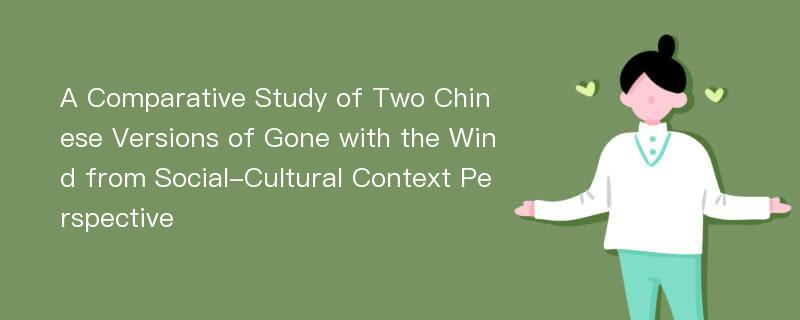
论文摘要
从20世纪70年代晚期起,西方翻译研究有了迅猛的发展,出现了文化转向。一些学派提出了新的理论和研究方法,其中代表性的有:以Even-Zohar和Gideon Toury为代表的多元系统理论、以Andre Lefevere为代表的操控学派理论(翻译研究学派)及以Hans Vermeer和Christlane Nord为代表的功能主义理论。这几个学派虽在其研究领域各有侧重和创新,但他们的共同点是:把翻译看作是特定的环境(社会的、文化的、历史的)下进行的动态过程;开始从宏观的角度来探索影响翻译的外在因素,而不仅仅停留在语言学的角度。本文以操控学派和勒菲弗尔的理论为框架,以美国小说《飘》(玛格丽特·米歇尔著)的两个不同时期的中译本为研究对象,采用描述性的比较分析法,旨在揭示翻译是特定社会文化语境下的产物。本文从社会文化语境的角度去分析和研究Gone with the Wind的两个中译本(1940年傅东华所译的《飘》和1990年戴侃、李野光、庄绎传合译的《飘》),并回答下面三个问题:为什么这部小说在五十年后被重译?所选取的两个中译本在那些方面不同?哪些原因和因素造成了这些不同?全文共分五章。第一章简单介绍了该论文的研究背景、研究目的、研究问题及研究方法和主要理论框架以及研究意义。第二章是文献综述,也是全文的理论基础。第一部分回顾了传统的翻译标准并指出它们的不足:未能从宏观的角度去分析翻译。第二部分详细介绍了翻译研究中的文化转向及相关的学派和理论,着重介绍了操控学派和勒菲弗尔的理论:翻译是一种重写,它受主流意识形态和诗学的制约,操控文学在一定的社会以一定的方式发挥功能。意识形态关注的是社会应该或者可以是怎样的,而诗学则关注文学应该或者说可以是怎样的。第三部分回顾了一些对《飘》的几个中译本的评价和研究,主要是对傅东华译本的评价。第三章是个案研究。首先简要介绍小说及其中文译本,然后着重从内容和语言风格两个大层面并结合大量翔实有力的例子对两个译本进行比较,找出不同点。第四章对产生这两个不同译本的社会、文化和历史语境进行详细的分析,这也是本文的重点。基于前面的比较与分析,在第五章,作者得出全文的结论:翻译是特定环境下的动态活动,文学翻译具有时代性,每一个译本都有其形成的特定社会文化语境,人们应用发展的、辨证的眼光从宏观的角度去评价译作。
论文目录
中文摘要AbstractAcknowledgementsContentsChapter 1 Introduction1.1 Academic Background of the Research1.2 Major Theoretical Framework Used in the Research1.3 Purpose of the Research and Research Questions1.4 Methodology1.5 Research SignificanceChapter 2 Literature Review2.1 Traditional Translation Criteria2.1.1 Linguistic Approaches2.1.2 Literary Approaches2.2 The Cultural Turn in Translation Studies2.2.1 Even Zohar's Polysystem Theory2.2.2 Gideon Toury and His Theories2.2.3 The Manipulation School and Its Development2.2.4 Andre Lefevere and the Development of His Theories2.2.4.1 Lefevere's Theory of Translation as a Form of Rewriting2.2.4.2 Lefevere's Theory about Ideology and Poetics2.3 The Evaluation and Criticism on the Chinese Versions of Gone with the WindChapter 3 A Case Study Comparison of Two Chinese Versions of Gone with the Wind3.1 Brief Introduction to the Novel and Its Chinese Versions3.1.1 Introduction to the Novel3.1.2 Introduction to Different Chinese Versions3.1.3 Reasons for Choosing Fu's Version and Dai's Version for Comparison3.1.3.1 Long Time Interval3.1.3.2 Distinctive Features of the Two Versions3.2 A Comparative Study of the Two Versions3.2.1 Differences in Terms of Content Between the Two Versions3.2.1.1 Abridgement versus Integrity3.2.1.2 Rewriting of the Content versus Faithful Rendering3.2.1.3 Supplement versus Non-supplement3.2.2 Differences in Terms of Language Style Between the Two Versions3.2.2.1 Comparison on the Syntactic Level3.2.2.2 Comparison on the Lexical LevelChapter 4.Analysis of the Reasons for the Differences of the Two Chinese Versions4.1 The Social and Cultural Context of Fu's version4.1.1 The Social Background of Fu's Version4.1.2 The Special Ideology in Shanghai in 19404.1.3 The General Poetic Tendency in 19404.1.4 The Influence of Traditional Poetics upon Fu's Version4.2 The Social and Cultural Context of Dai's Version4.2.1 The Dominant Ideology in China around 19904.2.2 New Poetic Requirement in 19904.2.3 The Fourth Translation Wave and the Retranslation Boom in the 1980s4.3 The Influence of Ideology on Translators' Subjectivity4.4 Readers' Aesthetic Expectations and Requirements of the Two Times4.4.1 Readers in 19404.4.2 Readers in 19904.5 Different Translation Purposes of the Two Versions4.6 Different Translation Strategies in the Two Versions4.6.1 The Dominant Translation Strategy from the 1870s to the End of 1970s:Domestication4.6.2 The Dominant Translation Strategy in Chinese Literary Translation since the 1980s4.7 Language Change During the Two PeriodsChapter 5 ConclusionBibliography
相关论文文献
- [1].也谈翻译忠实[J]. 翻译论坛 2016(03)
- [2].时尚审美的流变与当代大众身份的生成[J]. 文化研究 2016(03)
- [3].论翻译的社会文化语境因素[J]. 黄冈师范学院学报 2009(05)
- [4].语言的社会文化语境[J]. 邵阳学院学报(社会科学版) 2008(03)
- [5].浅谈林纾译作对当时社会文化语境的影响[J]. 南昌教育学院学报 2011(12)
- [6].陈独秀翻译出版活动与近代社会文化语境[J]. 中国出版 2013(18)
- [7].从社会文化语境看女性语体的语用价值[J]. 黑龙江教育学院学报 2011(07)
- [8].社会文化语境下的语言习得——评《不同教育背景下的二语互动》[J]. 教育发展研究 2017(22)
- [9].印度公众理解科学调查的社会文化语境分析[J]. 科学学研究 2014(08)
- [10].社会文化语境对课堂效果影响的辨析[J]. 新课程学习(上) 2011(10)
- [11].课堂上的“太极”与“留白”——浅探社会文化语境的妙用[J]. 新课程(上) 2012(01)
- [12].文化视域与身份建构——读《林语堂自传》[J]. 名作欣赏 2012(20)
- [13].走出“泛中国画”的泥沼[J]. 美术观察 2012(03)
- [14].海外华人获得语写作探析[J]. 金陵科技学院学报(社会科学版) 2017(04)
- [15].历时社会文化语境下的主题与主题倾向关联性融合——兼论古汉语诗词英译批评的综合模式[J]. 广东外语外贸大学学报 2014(04)
- [16].英汉词汇内涵与社会文化语境探析[J]. 劳动保障世界(理论版) 2013(09)
- [17].社会文化语境下译者主观能动性之顺应观[J]. 井冈山学院学报 2009(05)
- [18].社会文化语境在文学作品翻译中的运用[J]. 青年文学家 2010(16)
- [19].制约课程改革的文化语境分析[J]. 湖南师范大学教育科学学报 2013(05)
- [20].翻译与文化再现[J]. 外国语文 2011(02)
- [21].从社会文化语境解析“封杀”[J]. 湖北社会科学 2012(06)
- [22].试论晚清社会文化语境下的翻译小说[J]. 宁波教育学院学报 2010(05)
- [23].语境因素对中西方文化交际的影响分析[J]. 校园英语 2014(04)
- [24].口译规范的描写研究:口译研究新的突破口[J]. 语言与翻译 2012(04)
- [25].论艺术的现代价值[J]. 文教资料 2009(26)
- [26].与古为新 对话土楼——土楼差异性的现代表达[J]. 福建建筑 2013(04)
- [27].浅析社会文化语境如何促进英语阅读理解能力的提高[J]. 英语广场(学术研究) 2013(04)
- [28].从语境因素看就职演说的语言特征[J]. 安徽工业大学学报(社会科学版) 2009(05)
- [29].中国电视纪录片的叙事转型[J]. 新闻界 2008(03)
- [30].论广告的社会文化语境[J]. 企业家天地下半月刊(理论版) 2008(03)
标签:社会文化语境论文; 意识形态论文; 诗学论文; 翻译研究论文; 动态活动论文;
A Comparative Study of Two Chinese Versions of Gone with the Wind from Social-Cultural Context Perspective
下载Doc文档
